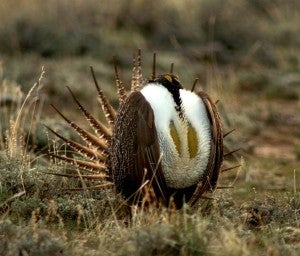This post was co-written by Terry Fankhauser, executive vice president of the Colorado Cattlemen’s Association and executive director of Partners for Western Conservation.
Stop us if you’ve heard this one before: A rancher, an environmentalist, and an oil company exec walk into a bar. The bartender looks up and asks, “Is this a joke?”
On the surface we may seem like an odd group, but ranchers, energy companies and environmentalists are finding each other willing partners in solving big conservation problems.
Colorado is one of 11 Western states where an iconic rangeland bird, the greater sage grouse, nests in high desert topography that’s also perfect ground for cattle ranching. And in recent years, Colorado’s booming oil and gas industry has encroached on the bird’s habitat.
That puts the bird’s future on a collision course with the state’s two largest economic drivers: agriculture and energy. The U.S. Fish and Wildlife Service faces a 2015 deadline to decide if the greater sage grouse should be protected by an Endangered Species Act listing. Listing could severely crimp both energy production and ranching across a vast territory.
Luckily, in Colorado we have the opportunity to prevent species protection from hindering our economy. The solution lies in Colorado’s 31.3 million acres of privately held working lands, many of them prime grouse habitat. Armed with a new way of thinking about species conservation, we’ve been able to engage those private lands in the solution.
What’s needed now is the right plan, one that includes the good work being done at the state level while incorporating a suite of tools that protect wildlife at landscape scale and allow our economy to flourish.
One tool that shows promise in addressing both the conservation and economic sides of the issue is a habitat exchange. In an exchange, landowners and ranchers across Colorado can earn revenue by generating habitat credits that oil companies can buy to offset the impact of their operations. And by adding another revenue stream to ranchers’ operations, it allows them to keep ranches in family hands while allowing continued flexibility to engage in a variety of agricultural practices.
As an added benefit in an era of tight budgets, habitat exchanges operate with no cost to the taxpayer, and government does not set the price for credits sold on the exchange — the buyers and sellers do. Plus, habitat exchanges — and the related, complementary approach of mitigation banking — use rigorous science to monitor and verify credit transactions and reports on progress to ensure species protection. Every credit sale makes species and habitat better off, which means bird populations can get healthier after an oil or gas well is drilled.
But to us, the best feature of a habitat exchange is its collaborative nature. In order to use the vast potential of privately owned lands to protect habitat in a way that strikes the right balance between species protection and economic growth, all stakeholders — farmers, ranchers, regulators, energy producers and conservationists — can come together to generate positive environmental outcomes.
By using tools that encourage collaboration and forward thinking like habitat exchanges, everyone — including the greater sage grouse — wins. That’s something we all can toast.










